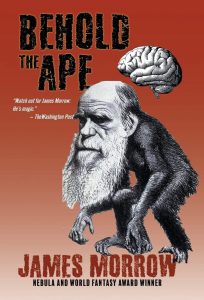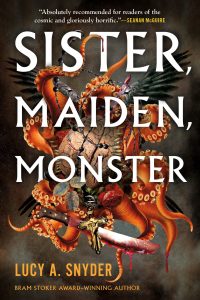Gary K. Wolfe Reviews Behold the Ape by James Morrow
 Behold the Ape, James Morrow (WordFire 978-1-68057-406-7, $32.99, 162pp. hc) April 2023.
Behold the Ape, James Morrow (WordFire 978-1-68057-406-7, $32.99, 162pp. hc) April 2023.
Satire has been a significant aspect of SF since long before anyone called it SF, so it’s a bit surprising to realize that relatively few SF authors have built their reputations largely as satirists. James Morrow has been at it for four decades, although it’s only one aspect of a career that has championed a kind of Enlightenment rationalism, including some complex historical novels such as The Last Witchfinder (2006) and Galapagos Regained (2015). On and off over the last several years, he’s expressed a playful interest in revisiting some of the seedier corners of pop culture, such as Godzilla movies (Shambling Toward Hiroshima, 2009), terrible 1950s TV programs (The Madonna and the Starship, 2014), and now low-budget horror movies and carnival sideshows of the 1930s and 1940s with Behold the Ape. His main character, Sonia Orlova, is introduced as a legendary cult figure whose B-movie roles included vampires, golems, werewolves, and most notably Korgora the Ape Woman. That last role is particularly important, since it’s what links the B-movie aspect of Morrow’s plot with its other major thread: the notion that Charles Darwin’s mind gets resurrected in Sonia’s Hollywood after the two halves of his brain are reunited. One had been kept on ice all those years, and the other ended up sharing space with the brain of a lowland gorilla, in one of those sideshows. The only problem is, the body that Darwin ends up with is that of the ape. As with many Morrow stories, there comes a point when the only reasonable response is: don’t even ask.
Sonia is a fascinating character, a brilliant master of disguise who earns comparisons to Lon Chaney even before her turn as the ape-woman. But she and her brother Vasily are precocious in other ways as well: Vasily first moves to Hollywood as a carpenter on movie sets, and later becomes a self-taught brain surgeon – he’s the one who eventually rejoins Darwin’s hemispheres-while Sonia, after rescuing the gorilla “Zolgar” from that sideshow and later spending time with the newly-restored Darwin, decides that she can promote rational thinking and specifically Darwin’s evolution theory in her movies, in contrast to the goofy pseudoscience of early-’30s films like The Island of Lost Souls, Dr. Jekyll and Mr. Hyde, or The Monster Walks. Darwin’s increasingly intemperate responses to pulp-movie “science” is one of the tale’s funniest features. Other characters, from Sonia’s SF radio show-writer boyfriend to studio heads to the gangsters who exploit Zolgar in the first place, don’t get a lot of stage time but are sketched with the efficiency of a good pulp supporting cast.
Part of the reason for Sonia’s decision to proselytize in favor of Darwinian reasoning is that the whole tale takes place in the wake of the 1925 Scopes trial in Tennessee, which is alluded to repeatedly. Most of the state anti-evolution laws were still on the books, and biology and science texts nationwide were still distorted to placate right-wing fundamentalists. (This aspect of the novel seems more immediate now than it probably was when Morrow was writing it.) There are also period cartoons and burlesques of Darwin scattered throughout the text, which give us a sense of how ripe for parody Darwin must have seemed to skeptics. But they aren’t specifically illustrations to Morrow’s story, and only really serve to provide atmosphere. For that matter, if it weren’t for the smart and determined Sonia, whose career we eventually get to see unfold over decades, the links between science denialism, evolutionary theory, and Depression-era horror films might seem pretty arbitrary. Fortunately, she’s up to the task. Behold the Ape may seem a pretty absurd garden at times, but it has at least one real flower in it, and some unarguably important ideas. We may need Morrow’s fables of reason now more than ever.
Gary K. Wolfe is Emeritus Professor of Humanities at Roosevelt University and a reviewer for Locus magazine since 1991. His reviews have been collected in Soundings (BSFA Award 2006; Hugo nominee), Bearings (Hugo nominee 2011), and Sightings (2011), and his Evaporating Genres: Essays on Fantastic Literature (Wesleyan) received the Locus Award in 2012. Earlier books include The Known and the Unknown: The Iconography of Science Fiction (Eaton Award, 1981), Harlan Ellison: The Edge of Forever (with Ellen Weil, 2002), and David Lindsay (1982). For the Library of America, he edited American Science Fiction: Nine Classic Novels of the 1950s in 2012, with a similar set for the 1960s forthcoming. He has received the Pilgrim Award from the Science Fiction Research Association, the Distinguished Scholarship Award from the International Association for the Fantastic in the Arts, and a Special World Fantasy Award for criticism. His 24-lecture series How Great Science Fiction Works appeared from The Great Courses in 2016. He has received six Hugo nominations, two for his reviews collections and four for The Coode Street Podcast, which he has co-hosted with Jonathan Strahan for more than 300 episodes. He lives in Chicago.
This review and more like it in the April 2023 issue of Locus.
 While you are here, please take a moment to support Locus with a one-time or recurring donation. We rely on reader donations to keep the magazine and site going, and would like to keep the site paywall free, but WE NEED YOUR FINANCIAL SUPPORT to continue quality coverage of the science fiction and fantasy field.
While you are here, please take a moment to support Locus with a one-time or recurring donation. We rely on reader donations to keep the magazine and site going, and would like to keep the site paywall free, but WE NEED YOUR FINANCIAL SUPPORT to continue quality coverage of the science fiction and fantasy field.
©Locus Magazine. Copyrighted material may not be republished without permission of LSFF.







